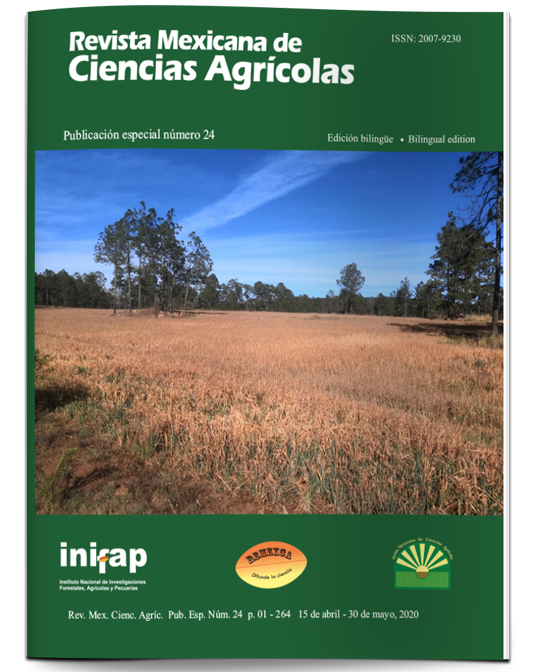Cocksfood forage yield inoculated with PGPB bacteria
DOI:
https://doi.org/10.29312/remexca.v0i24.2364Keywords:
Bacillus toyonensis, Ewingella americana, Microbacterium oxidans and Pseudomonas clororaphisAbstract
The PGPB bacteria have beneficial effects on crop yields. The aim of the present study was to determine the effect of five plant growth promoting bacteria on yield, plant height, SPAD units and content of protein in cocksfood defoliated every five weeks in spring and summer, under greenhouse conditions. A completely random design was used, with factorial arrangement 5x2x2, being the experimental unit a pot with ten stems, with four repetitions. The bacteria evaluated were: Ewingella americana (digestate), Ewingella americana (Soil), Pseudomonas clororaphis, Bacillus toyonensis and Microbacterium oxidans; compared with each other, and with the positive (triple 17) and negative (soil without fertilization) controls. The highest values of dry matter yield in spring were recorded by E. americana (3.5 g DM pot), while in summer it was B. Toyonensis. The height values did not register differences (p> 0.05) in both epochs, the SPAD units only in the summer and E. americana registered the lowest values (1.8). The protein content evidenced that the controls were inferior to all the treatments that were inoculated. The evaluated bacteria recorded effects on all evaluated variables and were superior to inorganic fertilization and unfertilized soil.
Downloads
Downloads
Published
How to Cite
Issue
Section
License
The authors who publish in Revista Mexicana de Ciencias Agrícolas accept the following conditions:
In accordance with copyright laws, Revista Mexicana de Ciencias Agrícolas recognizes and respects the authors’ moral right and ownership of property rights which will be transferred to the journal for dissemination in open access. Invariably, all the authors have to sign a letter of transfer of property rights and of originality of the article to Instituto Nacional de Investigaciones Forestales, Agrícolas y Pecuarias (INIFAP) [National Institute of Forestry, Agricultural and Livestock Research]. The author(s) must pay a fee for the reception of articles before proceeding to editorial review.
All the texts published by Revista Mexicana de Ciencias Agrícolas —with no exception— are distributed under a Creative Commons License Attribution-NonCommercial 4.0 International (CC BY-NC 4.0), which allows third parties to use the publication as long as the work’s authorship and its first publication in this journal are mentioned.
The author(s) can enter into independent and additional contractual agreements for the nonexclusive distribution of the version of the article published in Revista Mexicana de Ciencias Agrícolas (for example include it into an institutional repository or publish it in a book) as long as it is clearly and explicitly indicated that the work was published for the first time in Revista Mexicana de Ciencias Agrícolas.
For all the above, the authors shall send the Letter-transfer of Property Rights for the first publication duly filled in and signed by the author(s). This form must be sent as a PDF file to: revista_atm@yahoo.com.mx; cienciasagricola@inifap.gob.mx; remexca2017@gmail.
This work is licensed under a Creative Commons Attribution-Noncommercial 4.0 International license.



